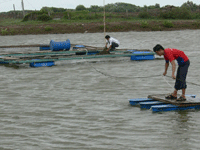 Mr. Vu Dinh Chuan who resides in
Mr. Vu Dinh Chuan who resides in
Mr. Vu Dinh Chuan who resides in
According to Engineer Nguyen Van Hung - the Center for Advanced Science and Technology, the unit that deployed the model said: In the searching process for households to implement the model, the Center has collaborated with the Farmers Association of Tan Hai Commune and the family of Mr. Chuan has been introduced. Through surveys, we found, his breeding pond which is used to keep shrimp but it is not effective due to environmental pollution. However, conditions of the pond are suitable for keeping seabass, so we decided to implement a pilot study.
After participating in the model, Mr.Chuan has bred 10,000 test breeding seabass in a breeding area over 5,000 m2 with some tilapia. Different from other models, the engineers have allowed combining breeding seabass with tilapia. Tilapia have been bred in order to take advantage of the raising water area, without food, tilapia can eat algae in water and also made extra food for seabass to save costs in the process of breeding.
To make the process of breeding success, the engineers of the Center have requested the owner of model to perform a number of preparations such as: designing the pond, processing the pond bottom, because they are factors contributing to create a success of the seabass breeding model. The seabass breeding ponds are often rectangles with size of 5,000 m2 to 2 hectares, the depth from 1.2 to 1.5 m. Each pond should have separate water supply and drainage in order to facilitate the replacement of the water. Ponds should have flat bottom and slopes down to drainage. Because tilapia like to build nest for spawning in the depth from 0.3 to 0.6 m, so the seabass breeding pond combined with tilapia for reproduction should have staircase form or pond with a high end and a low end. The surface of ponds should be ventilated, the edge of ponds should be clear not to frogs, snakes take cover to kill young fish. The pond bottom processing is done carefully to clean up plants and grass in ponds and the edge of pond, fierce fish (seabass, snakes, sea-snakes (Lapemis hardwickii gray) ...) in ponds, limited the rate of loss of breeding fish during the keeping process. Seabass species is quite easy to breed, so when raising, farmers need only to choose the breeding camp that ensure to supply good breeding fish, without sick to buy. At the same time they should also note the fish looks to choose male or female fish. When starting to breeding they should be interested in environmental factors such as the salinity, alkalinity.
In addition, the engineers also disseminate some measures of raising techniques such as: in the process of breeding, because of maintaining the natural food in ponds, farmers should limit changes to pond water as breeding combination. Water level of the pond should always be maintained > 1.2 m. In the first two months they need not to change water many times, they should maintain a stable status of water of breeding ponds. Besides, as water quality, it can be conducted to change water several times a month. Farmers should check natural food and regularly check the fluctuation of oxygen mix, check the alkalinity, pH ... especially in the weather fluctuations (murky, rainy ...) to adjust for the appropriate.
With the technical guidelines of the Center for Advanced Science and Technology, the number of seabass and tilapia in the pond has increased. Up to now, although they have not harvested in bulk, but an average day Mr. Chuan sells over ten kilograms to his customers. With average selling price of 45 to 50 thousand dong/kg, estimated, not only to pay back the invested capital but Mr. Chuan also get nearly 10 million dong of profit, of which, the breeding pond is still about 50% - equivalent to an output of one ton of unharvested seabass and tilapia. According to Mr. Chuan, this model initially has had a quite good result, with high profits. With this success, Mr. Chuan has invested capital himself to raise over 10 thousand breeding fish in a pond of 9.000m2.
From the success of Mr. Chuan’s seabass breeding model, we can see, the commercial seabass breeding process combined with raising tilapia is a process that is easy to make and it will bring a good effect for aquaculture people at brackish coastal areas. Seabass is a species with economic value, easy to keep because they can bear the environmental conditions, with many kinds of food so they should be appropriate breeding fish for people. The seabass keeping in intensive shrimp ponds or other ponds is a technical solution that is completely feasible, contributing to diversify the breeding aquaculture species. According to comments of Engineer Pham Minh Cong – the Center for Advanced Science and Technology, from the initial results showed that, Seabass suits to water environment in Tan Hai Commune, so after this testing model, in the future the Center will continue to expand the transfer this technique for households in the Commune and in some other breeding areas in the province.

 Previous page
Previous page Back to top
Back to top







